
What are my utility’s solar policies and rate plans?
Understanding which metric your utility provider is using to measure your energy usage can give an advantage in deciding which plan is right for you. There are two types of plans that your utility bill will fall under, either a Time-of-Use plan or Tiered plan. Traditionally a residential electric bill will be on a tiered plan, whereas office spaces are often on a Time-of-Use plan. Neither utility plan is objectively better than the other, but one may be more cost-efficient for the individual depending on their usage habits. Also, it is important to know that most utility companies require you to be on a time of use plan after installing solar (see solar and time of use section).
Note that the following information is taken from the rates of Southern California Edison and these prices, times and usage amounts will differ slightly depending on your utility provider.
Tiered Plan
A tiered utility plan is a relatively simple model. It is a 3 tier system established on a base allocation of usage allotted to you depending on what region you live in and its respective climate conditions.
The map for SCE shows how the regions are separated and numbered.
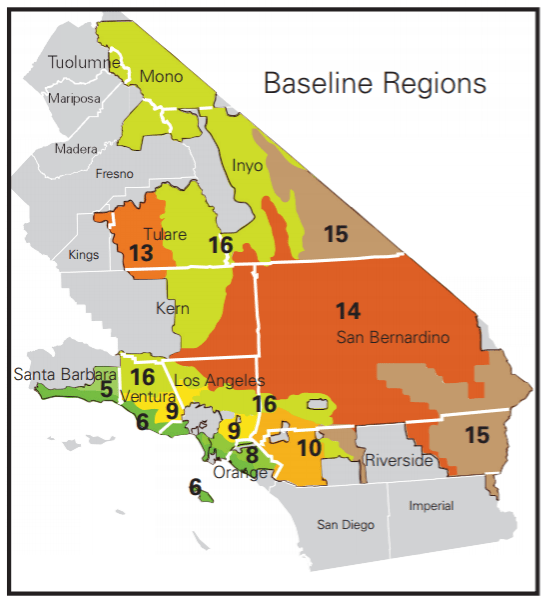
Using your region’s number you can use the chart to find out your baseline allocation.
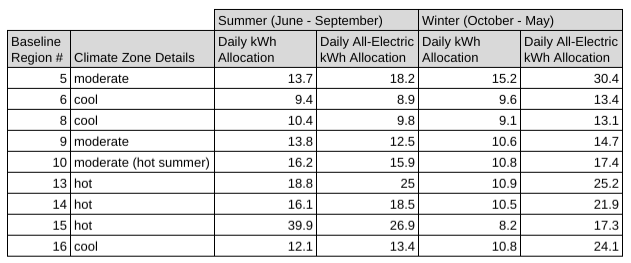
Your utility company will begin each billing period by putting you at the Tier 1 rate, which has the lowest price per kilowatt-hour (kWh). If you use more energy than the baseline allocation your rate will climb to tier 2. If one further surpasses the second tier by using 400 percent or greater of the baseline allocation you will be moved into tier 3. With each tier, the price per kWh goes up. These rates will change depending on your location and provider but for an individual whose utility provider is Southern California Edison, tier 1 is 17 cents per kWh, moving to 25 cents per kWh in tier 2 and finally ending at 35 cents per kWh in tier 3.
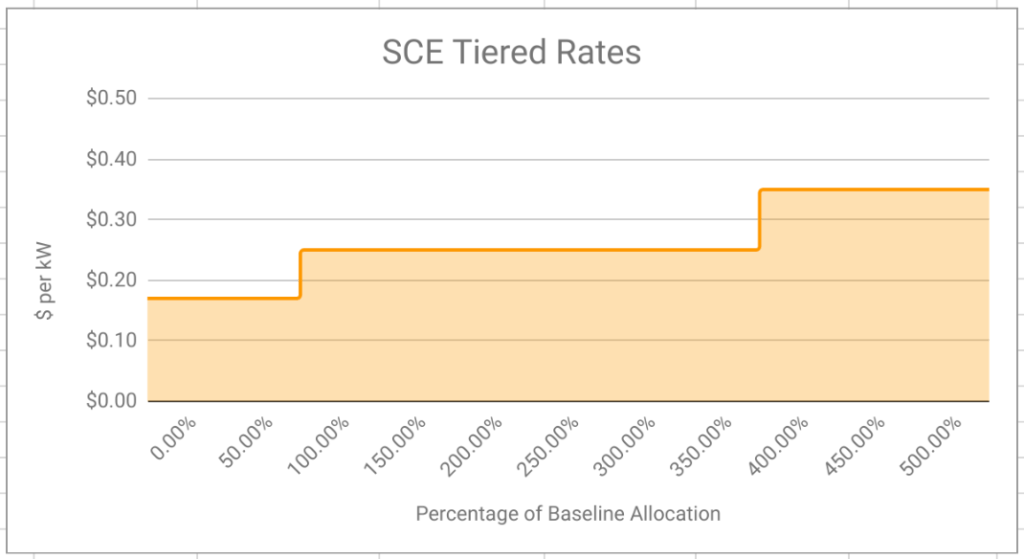
Time of Use Plans
A time-of-use (TOU) utility plan is a little more complicated than the tiered utility system. Time-of-Use plans have significant variance in rates and times (Southern California Edison has 5 different plans each with 2 different rates depending on the season). With a lot of choices, it is important to understand how the plan works in general. Time of use plans charges the user differently depending on when in the day you are using electricity. There are usually three categories that a 24 hour period is broken down into. While aspects of the plan change depending on the provider they all follow a similar trend. There is a price category for the time with the least amount of users (at Southern California Edison called super off-peak) often is in the range of 10 pm to 8 am. The second category (at Southern California Edison called off-peak) generally happens twice a day in the range of 8 am to 2 pm and 8 pm to 10 pm. The most expensive category usually called on-peak occurs during the hours of the most electric users, often between 2 pm and 8 pm.
Our SCE TOU chart below gives you a good comparison look at each of the plans with their rates and charges.
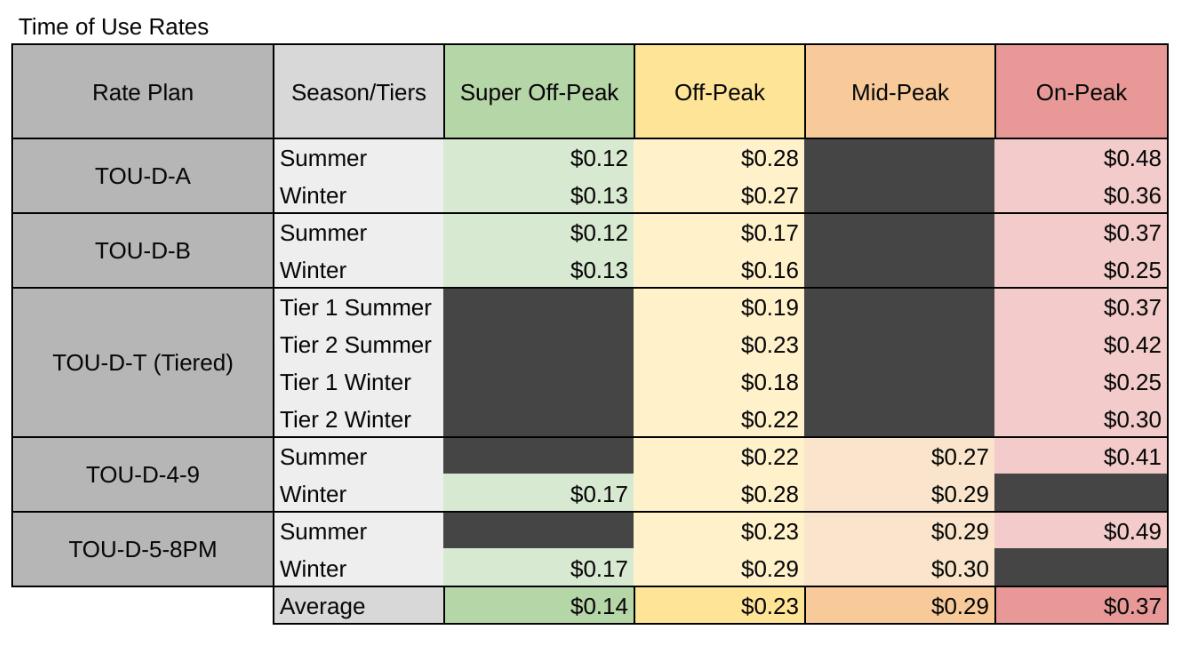
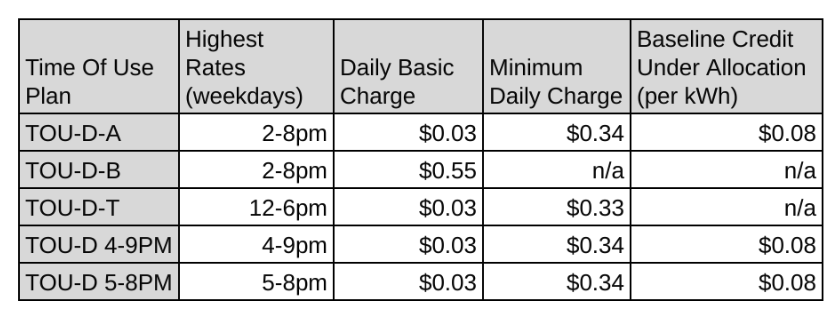
So what utility plan is better for you? According to SCE:
- TOU-D-A
- Better for low and medium energy users (less than 700 kWh/month)
- Features higher peak rates that are offset by a monthly Baseline Credit
- TOU-D-B
- Better for high energy users (more than 700 kWh/month)
- Features lower peak rates, but a higher daily basic charge and no baseline credit
- TOU-D-T
- Combines time of use and tiered rate pricing for those that prefer to keep a tiered aspect
- Tier 1 = up to 130% baseline, Tier 2 = 130%+
- TOU-D-4-9pm
- Better for customers who stay up late
- May benefit smaller households in coastal areas with moderately sized homes or condos
- TOU-D-5-8pm
Net Energy Metering (N.E.M.)
What is Net Metering?
Going solar automatically puts you onto a time-of-use plan. This is beneficial because conveniently the excess energy created by your panels is at it’s most during time-of-use peak hours, with net metering 2.0 you will see a reduced utility bill.
Net metering credits you for the excess electricity your panels produce you don’t use and sends it back to the electrical grid for others to use. If your system is able to surpass your usage, net metering is a means to save this energy to either use later or sell to your utility provider. NEM is the most common way that utilities compensate homeowners for going solar and is a mandatory program in most states.
Summer and winter months do have variations in production because of the longer and shorter days respectively but are fairly predictable. Because of the variations, solar panel systems with typically overproduce during the summer and underproduce in the winter. Most solar companies take this into consideration to offer a system with a net energy goal of being even for the entire year.
Homeowners typically have the option to do a monthly or a yearly “true-up” which is when they either owe the utility company or the utility company owes them.
How does net metering work with your system?
Solar energy systems produce electricity from sunshine, the more sunshine your system receives, the more power produced. Solar panels typically hit peak electricity production in the afternoon, when there is the most amount of sunshine on your panel which is also the time the average person is at work. NEM ensures that this energy doesn’t go to waste.
What happens with excess electricity?
Excess electricity produced by the system is not lost with net metering but instead, it is fed back into the grid. When this happens, your meter will actually run in reverse and when your system is not producing enough electricity on any given day, you can simply draw power back from your utility. Net metering ensures that excess production will still be used and your shortages will be met. As a result, you can save thousands of dollars on electricity costs over the lifespan of your solar panel system!
When your solar panels produce more electricity than you use over the course of a month, your utility bill will receive a credit based on the net number of kilowatt-hours you gave back to the grid. Meaning if you produce less electricity than you use in a given month, you simply buy electricity from your utility to make up the difference.
For the most up to date, state net metering policies refer to the Database of State Incentives for Renewables & Efficiency® (DSIRE).
Southern California Edison Tiered & Time of Use Calculator
We have come up with a guide to compare the different rate plans. Please fill out the form below to gain access.

